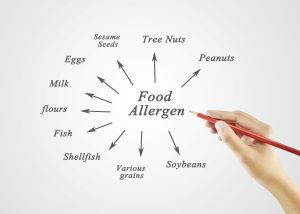Managing Food Allergen Risks
 Approximately 4 percent of adults and up to 8 percent of children experience true food allergies. True food allergens are proteins. The difference between an allergy and intolerance is how the body handles the offending food.
Approximately 4 percent of adults and up to 8 percent of children experience true food allergies. True food allergens are proteins. The difference between an allergy and intolerance is how the body handles the offending food.
In a true food allergy, the body's immune system recognizes a reaction-provoking substance, or allergen, as foreign and produces antibodies to halt the "invasion." As the battle rages, symptoms appear throughout the body. The most common sites are the mouth (swelling of the lips), digestive tract (stomach cramps, vomiting, diarrhea), skin (hives, rashes or eczema), and the airways (wheezing or breathing problems). There is no cure for food allergies, the only course is strict avoidance of an offending food. For an individual with food allergies, the biggest problem is knowing whether an allergen is contained in a particular food. Food intolerance is due to a chemical deficiency (commonly lack of a specific enzyme) and causes problems with digestion. Lactose intolerance is an example of food intolerance.
Frequently Asked Questions
The United States Food and Drug Administration (FDA) has identified nine foods (or food ingredients) that are responsible for 90 percent of food allergic reactions. Those foods are milk, eggs, fish, crustacean shellfish, tree nuts, peanuts, wheat, soybeans, and sesame. Under the FASTER Act of 2021, sesame is recognized as the 9th major food allergen effective January 1, 2023.

Yes. The leading cause of food recalls in recent years is due to the presence of undeclared allergens. Undeclared allergens end up in food due to two main reasons, mislabeling of the finished product and allergen cross-contact. Mislabeling occurs when a finished product label does not list an allergen in the ingredient statement when, in fact, the product contains an allergen. This can occur due to using the wrong label during packaging or not including allergenic ingredients in the finished product ingredient statement.
Allergen cross-contact is when a residue or trace amount of an allergen unintentionally crosses over into a product that doesn’t have that specific allergen. Cross-contact is generally the result of environmental exposure during food processing or handling. It can occur when multiple foods are manufactured on the same processing line, through the misuse of rework, a result of ineffective cleaning or from employee practices.
Food manufacturers need to evaluate their operations to recognize and develop plans to control undeclared allergens. The first step in developing an allergen control plan would be to conduct a risk assessment to understand what allergenic ingredients and foods exist in the facility and where they are introduced into the process. Next, once you have identified where allergen hazards exist in your facility you need to implement controls at those steps to reduce or eliminate the allergen hazard. Your allergen control plan must include training of personnel from management, purchasing, and maintenance to production line employees. Review of the allergen control plan must be done whenever a new ingredient is added, when processes or protocols are changed, or when new products or equipment are introduced into the facility. Understanding the potential consequences to a consumer with a food allergy will reinforce the importance of following the proper control procedures. It will also be important to have an ongoing monitoring system to verify that all control points are being consistently met.
The following are areas where allergen hazards may occur and where controls can be implemented.
Product Research and Development/Engineering and System Design
- Consider the allergenic nature of the ingredient, is there a non-allergenic ingredient that could be used instead?
- Avoid using allergenic ingredients in such low amounts when they have no or minimal functional effect in the finished product.
- Design the product flow so that allergenic ingredients are added at the end of a production line thereby limiting equipment exposure to allergens and potential allergen cross-contact.
- Design and install equipment for easier cleaning, inspection, and maintenance.
- Design production lines to isolate allergen addition points, dedicate re-feed systems, ensure product containment, and eliminate crossover of conveyor lines.
- Design traffic patterns and airflow in the production facility to prevent allergen cross-contact.
- Dedicate production systems, lines, and employees to handle only allergen or non-allergen products.
Raw Material/Ingredient Purchasing, Transportation, and Storage
- Ensure suppliers have a documented and implemented allergen control plan.
- Require letters from suppliers that guarantee the ingredients you purchase do not contain undeclared allergens and that they will notify you of any changes to the allergen status of the ingredients.
- Know the ingredients, consider processing aids and rework that goes into the product.
- Don't purchase reconditioned ingredients or oils.
- Ensure proper sanitation or dedicated use in transportation of bulk ingredients or shipping containers that are re-used.
- Review specifications or ingredient statements before substituting raw materials.
- Store allergenic ingredients separately to prevent cross-contact.
- Store like allergens together and do not store allergens over non-allergen-containing products.
- Clean up all spills immediately to prevent potential allergen cross-contact.
- Clearly label raw materials to indicate they contain an allergen.
Production and Scheduling
- Dedicate production systems, and use separate lines, equipment, rooms, or even facilities where necessary.
- Dedicate tools, containers, and utensils and clearly mark them or use color coding to identify allergenic ingredients and/or products.
- Restrict personnel working on processing lines containing allergenic ingredients from working on non-allergenic production lines.
- Minimize the reuse of processing and/or cooking media such as water or oil. If cooking media is reused, test to validate there is no cross-contact for non-allergen products.
- Production scheduling: make products with allergenic ingredients all at one time or at the end of a production run, then perform a complete clean-up before running other products.
- Develop an allergen matrix or changeover grid to identify what practices or production changes need to be made between flavors or products (spray down or full clean up).
- Do not allow the reuse of single service articles such as tray liners.
- Provide lockouts on equipment that uses or supplies allergenic ingredients.
- Protect work-in-process from cross-contact with other products on adjacent carts, conveyors, etc.
- When sampling the product in-process, be certain that the sampling device is sanitized appropriately between products.
- Allow adequate clean-up time between production runs.
Use of Rework
- Have a documented rework plan including designated uses for re-work, maintaining usage records, and other rework controls to track allergens through the system into the finished product.
- Only rework allergenic containing ingredients or products into the same formulation – “like into like” or “exact into exact”
- Clearly label all rework; use of color tags, containers, plastic liners, or barcoding to identify allergen ingredient-containing products.
- Ensure that re-feed systems are properly contained.
Labeling and Packaging Materials
- Ensure label approval processes are in place for new products or changes to current products.
- Check labels on incoming ingredients. A supplier may have sent the wrong product or used the wrong label.
- Verify label accuracy, and update to reflect the current formula.
- Ensure compliance with labeling regulations: Food Allergen Labeling and Consumer Protection Act of 2004 (FALCPA) | FDA generally requires declaration of all ingredients; the exception to this include spices, some colors, flavors, and processing aids and incidental additives at insignificant levels or that have no technical function or effect. If an incidental additive or processing aid is derived from an allergenic ingredient, it must be included on the label.
- Limit the use of precautionary labeling (such as "may contain") in lieu of good manufacturing practices. Do not list ingredients that are not in the formula.
- Manage excess packaging materials. Remove outdated containers or labels from the plant.
- Monitor, document, and verify the correct label at all changeovers as they occur.
- Consider cross-contact potential on packaging equipment.
- For packaged, unlabeled products (such as individual granola bars), develop systems to assure that the correct product is packaged into the containers with ingredient declarations.
- Use a lot numbering system on raw materials through to finished products to ensure recovery of all products in the event of a recall.
- Conduct traceability exercises such as a mock recall to verify product traceability.
Sanitation
- Have standardized procedures for sanitation operations (SSOPs) and ensure employees are properly trained to follow these procedures.
- Use appropriate cleaning methods (wipe/scrape, vacuum, soap and water wash, proper chemicals).
- Have proper equipment and tools available.
- Focus on hard-to-clean areas including valves, pumps, and dead spots.
- Ensure adequate lighting in the proper locations (including flashlights to check inside equipment).
- Move equipment as necessary to make it easily accessible for cleaning.
- Disassemble equipment where and when necessary.
- Focus on results, not necessarily the time or process.
- Evaluate sanitation effectiveness, validation of cleaning by visual inspection, bioluminescence testing, or enzyme-linked immunoassay (ELISA) testing.
- Ensure proper storage of clean items.
- Ensure that maintenance tools used in raw and finished product areas are not potential sources of cross-contamination (consider color coding for specific areas or products, or cleaning procedures to reduce contamination).
- Specify employee practices - hand washing at appropriate times (for example after handling a product that contains allergens, such as peanuts); proper hand washing procedures; clean clothing/aprons.
Training and Education
- Provide training on allergen awareness and control for all employees at all levels of the company.
- Training points to include: defining allergens, consequences to sensitive people, importance of allergen control, most common areas where problems occur, and control measures.
- Provide specific documented training to employees as dictated by their job responsibilities. Such as employees responsible for product labeling at product changeovers on the production line, sanitation/allergen cleaning verification activities, and label verification of incoming packaging material.

